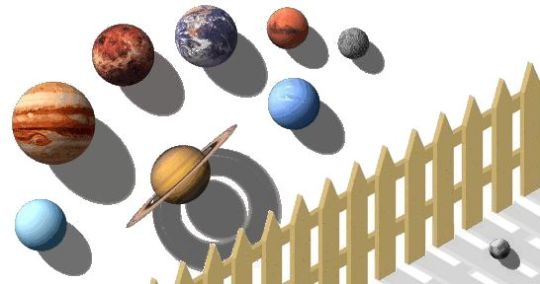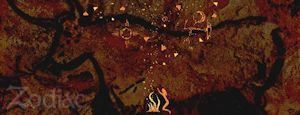
 The old school definition of the planets was “Any of these seven celestial bodies, Sun, Moon, Mercury, Venus, Mars, Jupiter, and Saturn, that shineth and wandereth about the starry heavens” or something like that. The specific language has been updated a few times over the years.
The old school definition of the planets was “Any of these seven celestial bodies, Sun, Moon, Mercury, Venus, Mars, Jupiter, and Saturn, that shineth and wandereth about the starry heavens” or something like that. The specific language has been updated a few times over the years.
In February of 2006 the International Astronomical Union (the governing body when it comes to screwing around with the names) said this:
“The IAU notes the very rapid pace of discovery of bodies within the Solar system over the last decade and so our understanding of the Trans-Neptunian Region is therefore still evolving very rapidly. This is in serious contrast to the situation when Pluto was discovered. As a consequence, The IAU has established a Working Group to consider the definition of a minimum size for a planet. Until the report of this Working Group is received, all objects discovered at a distance from the Sun greater than 40 AU will continue to be regarded as part of the Trans-Neptunian population.”

Okay fine. Meanwhile the Trans-Neptunian population waited in limbo. But then a few months later the IAU narrowed it down to a few simple rules (slightly edited):
- A planet is a celestial body that…
- Goes around a star.
- Is sort of round-ish.
- Has cleared out its neighborhood of the riff-raff, like a boss.
- A “dwarf” planet is a celestial body that…
- Has a name that rhymes with Bluto, or maybe a couple of other words.
So here is a list of heavenly bodies that wandereth about, more or less officially.
 Mercury – instant messenger and email admin of the gods.
Mercury – instant messenger and email admin of the gods.
Closest planet to the Sun and the eighth largest and least noticed.
mass: 3.30 x 1023 kg
orbit: 57,910,000 km (0.38 AU) from Sun
diameter: 4,880 km
Being closest planet to the Sun means always being very near the Sun and so it is difficult to see in the early sunset or pre-dawn, depending on when you come calling. It is probably best pursued with small telescopes and binoculars when at its greatest eastern or western elongation, that is when its angular deviations are at a maximum with the Sun as it appears to swing back and forth from the morning to the evening skies.
Like Chipotle’s restaurant, Mercury has almost no atmosphere. So the side facing towards the Sun is sizzling hot and the side facing away is icy cold like a microwaved leftover burrito.
Mercury has no moons. Believe me we’ve checked and it doesn’t even have a place to hide them.
 Venus – goddess of love and beauty and true understanding of just how disgusting men can be.
Venus – goddess of love and beauty and true understanding of just how disgusting men can be.
Second planet from the Sun and the sixth largest and yes she’s hot.
mass: 4.869 x 1024 kg
orbit: 108,200,000 km (0.72 AU) from Sun
diameter: 12,103.6 km (don’t judge)
Like Mercury, Venus shows phases when viewed with a telescope from the perspective of Earth. Because it is closer to the Sun than the Earth we can see her backside. When seeing part of the unlit side, Venus presents either a crescent or gibbous shape, much like our Moon, or me during the holidays. The reflected sunlight from Venus is very bright. On moon-less nights you may see your shadow from the light of Venus.
Venus is very hot, like 800 degrees hot. That’s because most of the carbon is in the atmosphere like a thick blanket, instead of in rocks the way carbon is on Earth. It’s a greenhouse-effect, which is something that was first proposed by Carl Sagan back before things like rocks and air and sunlight became political.
Venus has no moons but then why should it? It seems to be fine without them.

 Earth – the only planet that is not named after a god (it’s dirt).
Earth – the only planet that is not named after a god (it’s dirt).
Third rock from the Sun and the fifth largest and the cheapest to explore.
mass: 5.972 x 1024 kg
orbit: 149,600,000 km (1.00 AU) from Sun
diameter: 12,756.3 km
It was not until near the end of the 17th century that the idea began to spread and be accepted that the Earth is a planet in the same sense as the other planets that orbit the Sun. Until then, it was just “The World” and was the biggest thing there is, just go outside and see for yourself. It’s sometimes called a “Goldilocks Planet” because it’s not too hot and not too cold (so far).

Earth has only one moon, but it’s a doozy. It is unlike any of the other satellite bodies in the solar system. It is extremely large, yet relatively distant from our planet. Other moons of the solar system tend to be classified as either natural satellites or captured planetoids. The naturals are mostly large objects with circular orbits, very near the parent planet, and with orbits that are aligned closely with the planet’s equator. Captured planetoids on the other hand mostly tend to be mere pebbles with eccentric orbits inclined to the equator and relatively distant from the parent planet. The Earth’s moon does not fit into either of these categories very well. It’s big, far, with a rather circular orbit, but not aligned with our equator.
The Earth’s moon is unique and was probably formed way back when the Earth was in two parts that crashed together, sending a bunch of debris into orbit. If more debris had been involved, there might have been a whole second Earth created, which the IAU would have called Smearth.

 Mars – god of war and other national security and foreign policy issues.
Mars – god of war and other national security and foreign policy issues.
Fourth planet from the Sun and the seventh largest. Inhabited by robots.
mass: 6.4219 x 1023 kg
orbit: 227,940,000 km (1.52 AU) from Sun
diameter: 6,794 km
In an amateur telescope Mars varies greatly depending on its orbital relationship with Earth. When it is close, it is very easy to see a white polar cap and dark surface features, especially on the lower latitudes. But then that’s when the dust storms kick into high gear and you can’t see shit so you switch to looking at Jupiter.
Mars has two very small potato-shaped moons which are very close to the surface of the planet. Their names are Phobos and Deimos (Fear and Terror) after the children of the god of war in Roman mythology. Trust me, don’t offer to babysit them.
 Jupiter – King of the gods, this is not a democracy so shut up and bring me an asteroid.
Jupiter – King of the gods, this is not a democracy so shut up and bring me an asteroid.
Fifth planet from the Sun, the largest and most obtuse.
mass: 1.900 x 1027 kg
orbit: 778,330,000 km (5.20 AU) from Sun
diameter: 142,984 km (at the equator)
Viewing the surface features of Big Jupe depends greatly on seeing conditions. Usually a 6″ or 8″ diameter telescope will reveal the Great Red Spot. They say you can fit three Earths in the Great Red Spot but I don’t think anyone has actually tried. The lateral bands on the surface are alternately colored: The darker ones ranging from brick red to light peach and the lighter ones ranging from aqua to light grey. Sometime you will see a black dot slowly travelling across the surface of the planet; a shadow from an intervening moon.
Jupiter has at least 66 moons including four that were discovered in 1610 when Galileo was the first to view it through a telescope and he is believed to have said “What the…?” Their names are Io, Europa, Ganymede and Callisto. They can be seen easily through binoculars or a small telescope in spite of claims to the contrary by the Vatican. When told of Galileo’s discovery the pope reportedly said to him “Jupiter Schmoopiter. I’m smart and you’re stupider.”

Sixth planet from the Sun and the second largest and the true lord of the rings.
mass: 5.68 x 1026 kg
orbit: 1,429,400,000 km (9.54 AU) from Sun
diameter: 120,536 km (at the equator)
Saturn’s rings are beautiful even in small amateur telescopes, especially when the planet is at its greatest tilt to the Earth, exposing the maximum surface area of the ring system. The rings are extremely thin compared to their width. They are about 250,000 km or so in diameter, but they’re less than only one kilometer thick. The ring particles are composed primarily of water ice, and rocky particles with icy frosting.
Saturn has more than 30 moons. The hardest to ignore is Titan, which is prominent in views through a small telescope.
 Uranus – Jupiter’s grandpappy.
Uranus – Jupiter’s grandpappy.
Seventh planet from the Sun and the third largest and most fun to mispronounce.
mass: 8.683 x 1025 kg
orbit: 2,870,990,000 km (19.218 AU) from Sun
diameter: 51,118 km (at the equator)
It is difficult for beginners with small telescopes to find Uranus. It may appear as a bluish-green star. In slightly larger scopes it will look more like a disk and less like a point.
An interesting thing about this planet is that unlike most of the planets, which spin on an axis nearly perpendicular to the plane of the ecliptic, Uranus’ axis is almost parallel to the ecliptic. It seems tipped on its side like a ball rolling around the sun.
Uranus has at least 27 moons. The largest are the only major objects in the solar system not named after gods, besides Earth. Some are named after characters in Shakespeare plays and others are named after some characters in writings of Alexander Pope (not a real pope).
 Neptune – god of the sea and seashells and of starfish on the beach.
Neptune – god of the sea and seashells and of starfish on the beach.
Eighth planet from the Sun and the fourth largest.
mass: 1.0247 x 1026 kg
orbit: 4,504,000,000 km (30.06 AU) from Sun
diameter: 49,532 km (at the equator)
Like Uranus it is difficult for beginners with small telescopes to find it. It usually appears simply as a bluish-green star. In slightly larger scopes it will look more like a disk and less like a point of light.
Neptune has at least 13 moons. The biggest is named Triton which sounds a bit too much like Titan.
 Pluto – second class god of the nether regions and Trans-Neptunian bastard.
Pluto – second class god of the nether regions and Trans-Neptunian bastard.
Not actually named after Mickey Mouse’s dog which by the way is not even a real dog. Pluto also sneaks inside the orbit of Neptune for part of its orbit thus violating well established planetary restrictions and sparking renewed calls for immigration reform. It is tiny compared to a proper planet. Pluto is even smaller than seven of the solar system’s more popular moons.
mass: 1.27 x 1022 kg
orbit: 5,913,520,000 km (39.5 AU) from Sun (average distance)
diameter: 2274 km (LOL)
In earth-bound telescopes Pluto looks like a star but don’t be fooled. To know if you are even actually observing it instead of a star, make a drawing of the whole star field in the eyepiece when you think you have found Pluto. Come back in a couple of weeks and find the field again. If it has moved slightly in relation to the backdrop of stars that should at least narrow it down to something within our solar system. Then ask to see its papers.
Pluto has several moons including a moon named Charon which is named after the mythical ferry boat operator who takes souls across the River Acheron to Hades. Charon takes the pennies off of the dead people’s eyes as payment, which shows you just how cheap those demi-gods will work.

Carpe Noctem.














January 25, 2015
Astronomy